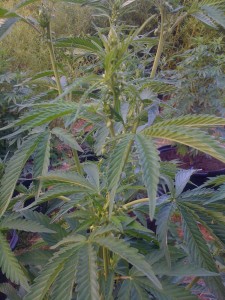SoHum’s off-grid lifestyle and our extremely rugged topography create special access challenges, whether by car or computer. We live on the dusty, tortuous, slide-prone backroads of both the physical landscape and the internet superhighway. We surf the web in high-clearance 4WD.
While many people are still on 16K-24K dialup modem connections and others with southern sky access have satellite internet, one local provider has found a way to bring high-speed wireless broadband to many remote areas via a network of repeaters that bounce the signal deep behind the Redwood Firewall—the 21st Century version of our perennially puncture-resistant Redwood Curtain.
The small white antennas barely visible at the top of this ancient redwood are in line-of-sight to a tower on a high ridge somewhere that in turn is line-of-sight to another tower and so on, bouncing the internet signal via microwaves to the residents in this narrow, wooded canyon. A ladder up the inside of the tree, hollowed out over the centuries by multiple wildfires, provides maintenance access. The steel ladder is a recent improvement over the old wooden ladder nailed up behind it.
And, no, your cell phone won’t work out here.




